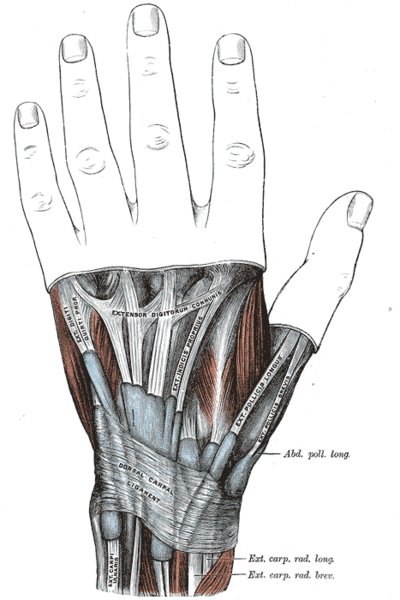De
Quervain Syndrome
(aka De Quervain's Tenosynovitis, Radial
Styloid Tenosynovitis, Blackberry Thumb)
What is De Quervain
Syndrome? 
De Quervain Syndrome is an inflammation of
the two tendons which provide articulation of the
thumb. The tendon moves inside a synovial sheath which
when inflamed thickens and swells, restricting the movement
of the tendon and can lead to the formation of painful
cysts.
Both the extensor pollicus brevis
and the abductor pollicus longus tendons are
employed to move the thumb away from the hand in the same
plane as the palm (i.e. 2-dimensional movement, or radial
abduction). Other tendons move the thumb
away from the palm of the hand (palmar abduction)
and are not affected by this Syndrome.
What are the
Symptoms of De Quervain Syndrome?
Common symptoms include
pain and swelling in the 'thumb side' of the wrist
and a noticeable reduction in the ability to grip The
pain can also radiate up from the wrist to the thumb and
down through the forearm, and worsens with use of the thumb
or hand. Any forceful pinching, twisting, gripping or
grabbing actions will heighten the pain. Sometimes a
reduced range of motion of the thumb will also occur.
A 'snapping' sensation when the thumb is moved indicates the
presence of a cyst which the tendons are moving over.
|
Finklestein's
Test
This test is used to diagnose De
Quervain Syndrome. To perform this test,
make a fist with the thumb under the
fingers. Then bend the wrist away from the
thumb side of the hand, towards the little
finger side of the hand. For most
individuals this test is mildly painful, but for
individuals suffering from De Quervain Syndrome
it is very painful.
|
What Causes De Quervain Syndrome to
Develop?
There is no clear consensus in the scientific community as to
the clear cause of De Quervain's Tenosynovitis.
The leading theories attribute the most likely cause to
repetitive movements of the thumb, especially when the thumb
is moved in a posture with significant abduction and
extension. Examples of this are thumb based trackballs,
and generating text with a cell phone (which has led to some
calling this syndrome "Blackberry Thumb").
Another cause is theorized to arise from performing
repetitive actions with the hands that require sideways
movement of the wrist while gripping the thumb (i.e. mousing
with some mice).
The syndrome occurs most frequently in individuals who are
between 30 and 50 years of age and is significantly more
common in women than men. Part of the reason for this
gender disparity is that is not uncommon to occur during and
after pregnancy.
What Movements Should be Avoided if you
have De Quervain Syndrome?
Any lateral movement of the thumb relative to
the hand or actions requiring the need to grip with the
thumb. Most conventional mice require a Static
Grip Force which uses the tendons affected by De
Quervain's Syndrome. Any pointing device which requires
movement of the thumb to perform mousing actions (i.e. thumb
based trackballs, or using a thumb button on a mouse or
touchpad) could also represent movements you would want to
avoid.
What Types of Products can be Used to
Help Prevent or Reduce the Symptoms and Incidence of De
Quervain Syndrome?
Orthopedic
Mice of the correct size for the user which properly
support the structure of the hand and minimize or eliminate
the need to exert Static
Grip Force will be of significant benefit. Touchpads,
Trackballs
and Central
Pointing Devices will eliminate the need to grip the
mouse, and when used properly will not require undesired
thumb movement.

